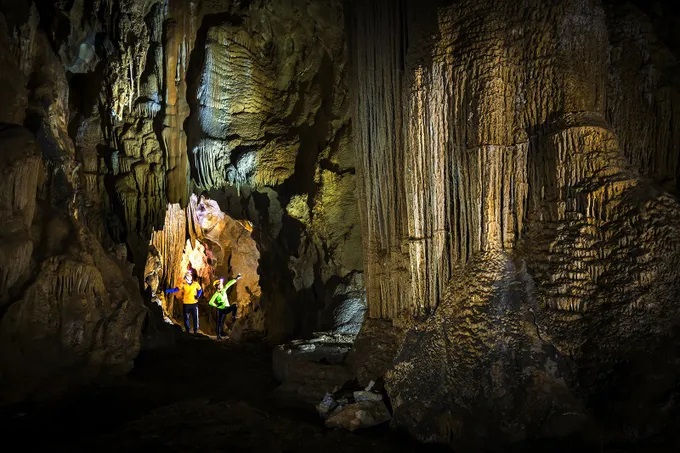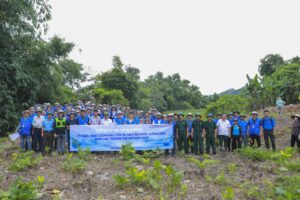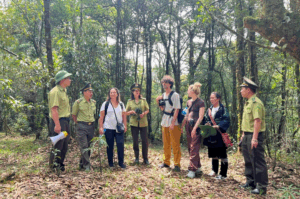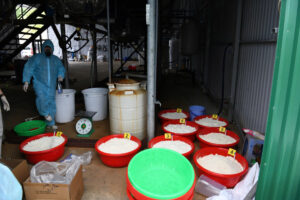Vàng Sín Phìn, a musical maestro from the northern province of Lào Cai, has dedicated himself to collecting musical instruments and preserving the folklore melodies of his people. Through painstaking study, Phìn has mastered the local musical instruments, ensuring that the mountainous music will be passed on to a new generation. Hồng Ninh and Cao Hương report.
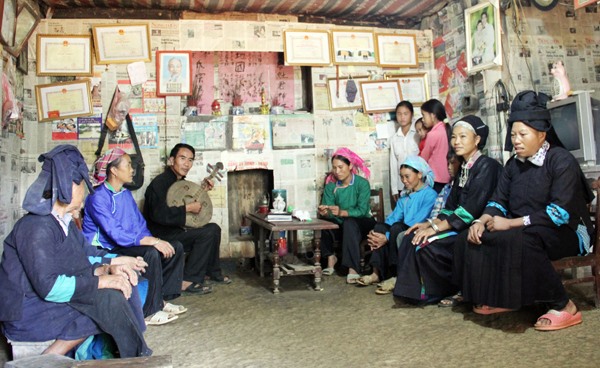
Group music: Folk artisan Vàng Sín Phìn (third from left) practices the Thu Lao people’s melodies with women in the village. — Photo baolaocai.vn
Vàng Sín Phìn is not an ordinary person. An exceptional artisan, considered to be a national treasure belonging to the Thu Lao ethnic minority people, he lives in Nàn Sán Commune in Si Ma Cai District in the northwest mountainous province of Lào Cai. Phìn has made a name for himself through his tireless efforts of collecting musical instruments, preserving the folklore melodies and the epic songs of his people, and then passing them on to the locals.
Phìn was born in 1962 in Nàn Sán hamlet. The passion for folklore and the melodies of the musical instruments ran in his blood since he was a child.
When he was 10, he started studying at the national cultural foundation, and then learned to sing from his father Vàng Sào Lèng. He also learnt to play the musical instruments from Vàng Tờ Sín, a local folklore artisan who was blind but had excellent playing skills.
After years of painstakingly studying until he was 18, Phìn mastered the skill of playing most of the musical instruments and learnt by heart many folk songs.
“The cultural folklore of the Thu Lao was developed through their daily life activities, which was passed down from one generation to another orally. These folklore conveyed intense feelings, affection and the lifestyle of the people. Among them, the most popular folk melodies, which are in the Thu Lao language, are called Kháo.
The ancient Kháo melody was sung in summertime, especially when farmers were on the field. The Thu Lao have a variety of beautiful songs to make acquaintances, such as kháo khíu tẻo soỏng (sung when guests arrive in the village) and love songs with sweet melodies kháo ní, xá khao ní (the song of exchanging love).
The Thu Lao use their melodies as a medium to greet and know each other, and it has become a part of the people’s lifestyle.
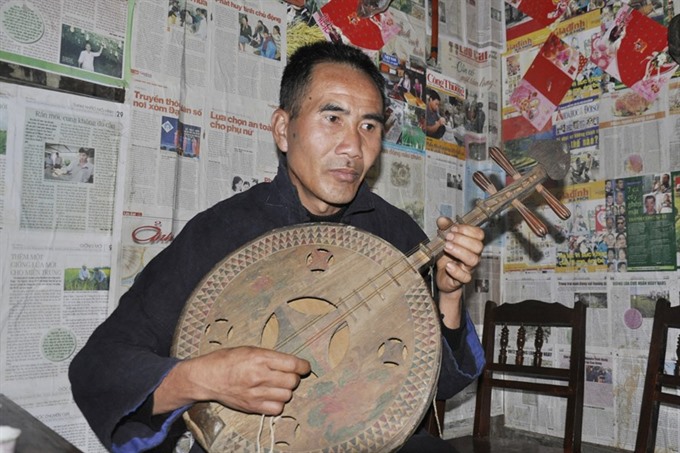
Interesting instrument: Artisan Vàng Sín Phìn with his ẳn tắng guitar. — Photo laodong.vn
While musical instruments produce the same tune to create the simple harmony, the must-have accompaniments are the ẳn tắng guitar (a musical instrument with four strings), tắng gàn guitar (musical instrument with three strings) and ẳng dìn guitar (one-string musical instrument).
“I am probably the luckiest person to have the last two instruments of Thu Lao people, ẳn tắng and tắng gàn guitars, which are used as accompaniments for the folk songs of my countryside. It is difficult to find these two instruments now; even in Si Ma Cai there are only a few left,” said Phìn.
While listening to the sound of the rain during the final summer days in his tiny house, Phìn took out an ẳng tắng guitar and played it for his guests.
Playing the kháo khíu tẻo soỏng melody is a means to show the cheerfulness and hospitality of the Thu Lao to the guests.
The guitar’s sound echoes through his flickering house on stilts, besides the terraced rice fields that are ripening vigorously.
His sound convinces the visitors why this man has such a huge love for the kháo melodies of his people.
He lowers his eyes, and his voice chokes with emotion when he is asked if there are others in his village who know how to play the musical instrument and sing these folk songs.
“With the development of the modern society, many exotic musical instruments and music genres have entered our village. Currently, there are hardly 20 persons who can play the guitars and sing the folk melodies. The youngsters are starting to forget how to hold a musical instrument, play the flute and sing folk melodies. Therefore, I hope I can organise more classes to teach the children the tunes of our ancestors,” he said.
Until now, he has helped some 20 people learn the kháo melodies.
Phìn also helped the provincial and central staff collect and translate over 130 Thu Lao folk songs into Vietnamese in Si Ma Cai and Mường Khương districts. Many of them were lost and took lots of time to collect.
He also travelled more than 100km to Lào Cai City with folklorists to translate the melodies and turn them into a book for young people.
Over the past eight years as a village chief, because of his devotion and contribution to the preservation and development of national culture, Phìn was named a folk artisan by the Association of Vietnamese Folklorists.
In 2015, he was nominated excellent artisan by the Ministry of Culture, Sports and Tourism. He was also awarded a certificate for his contribution to preserving the Thu Lao’s musical instruments. — VNS


